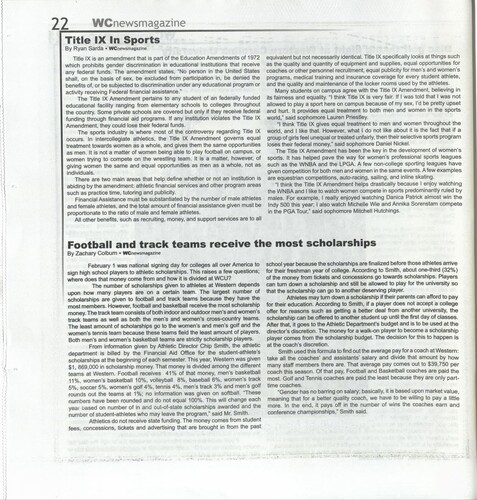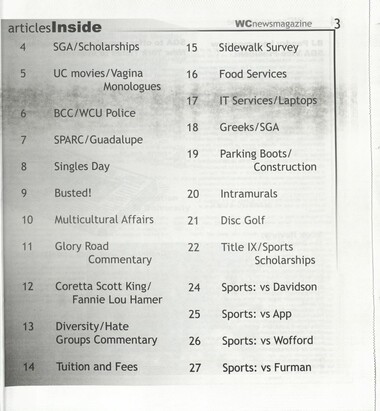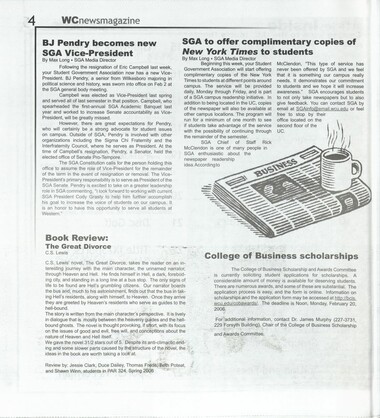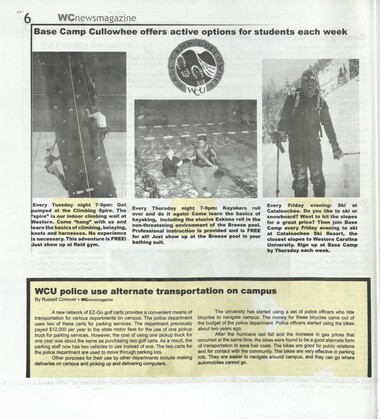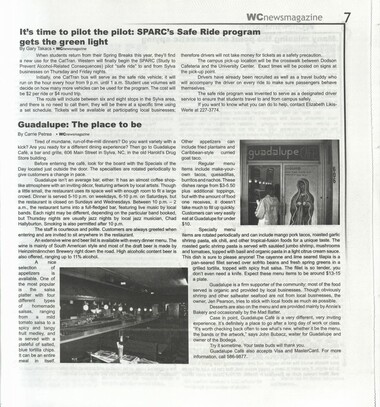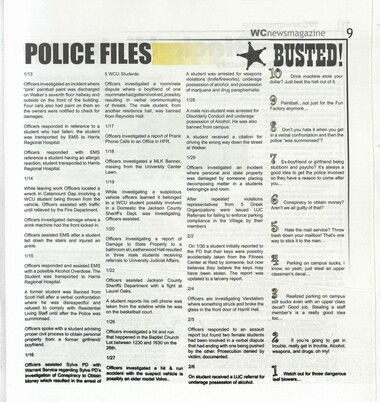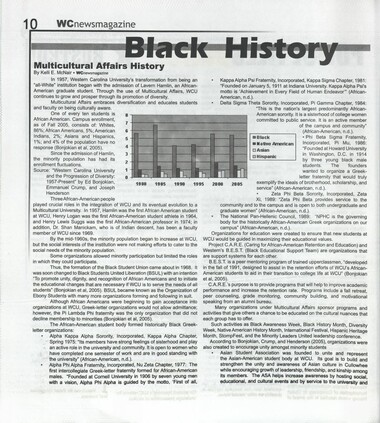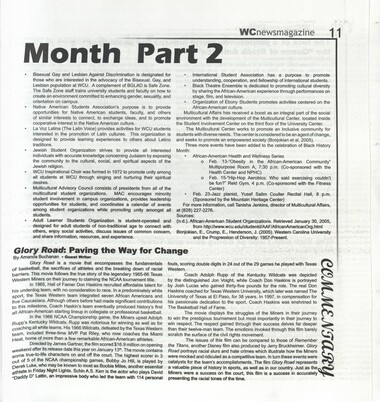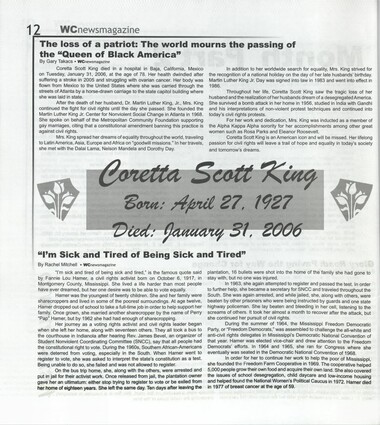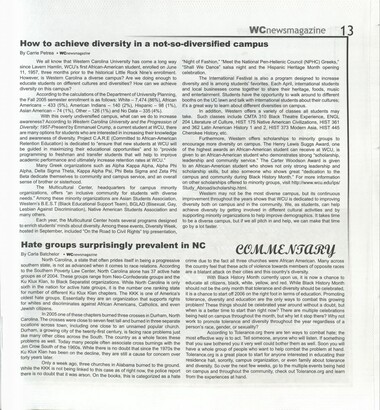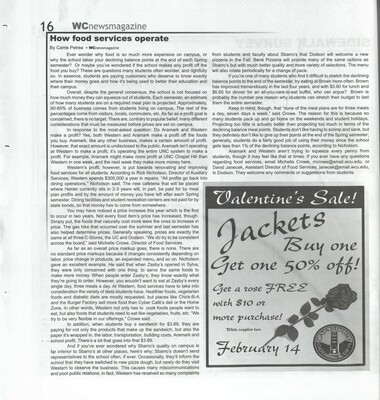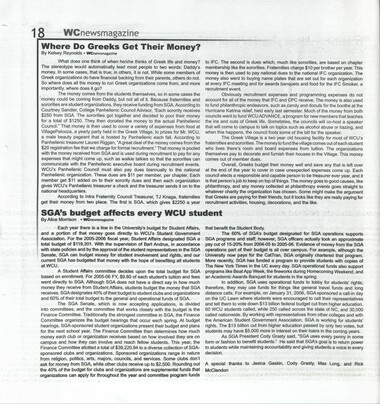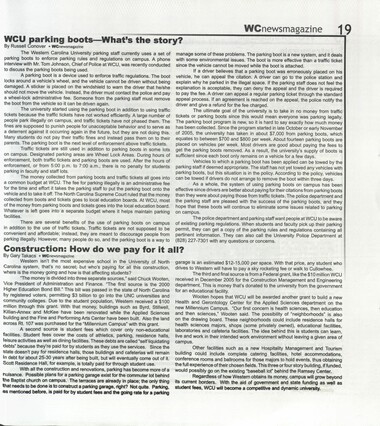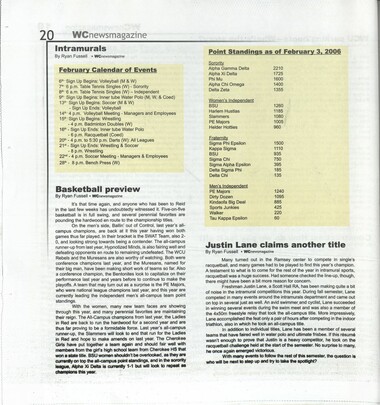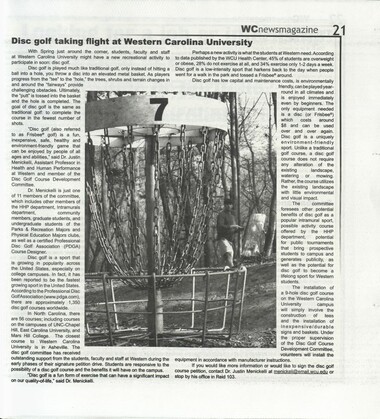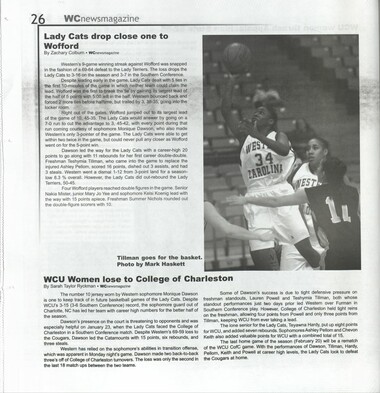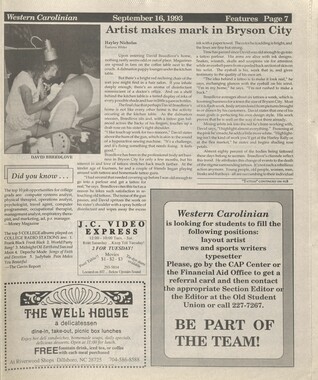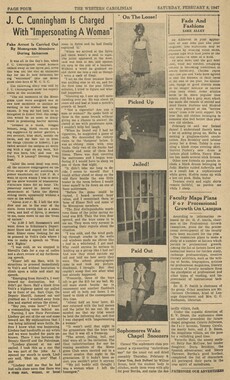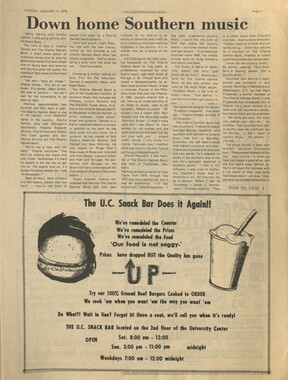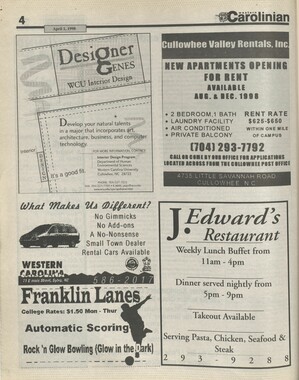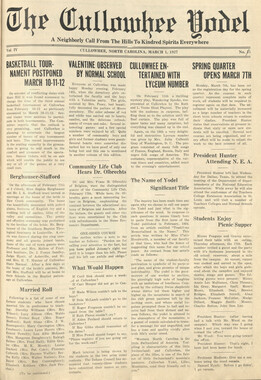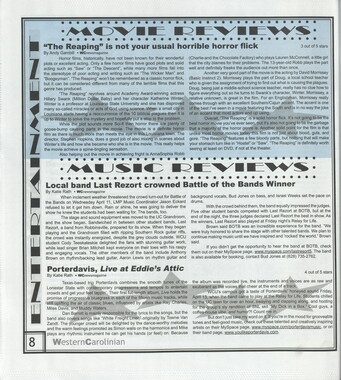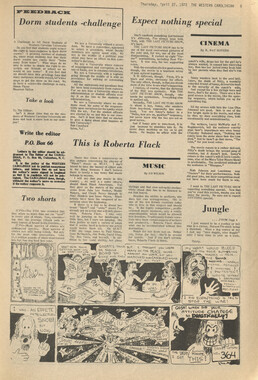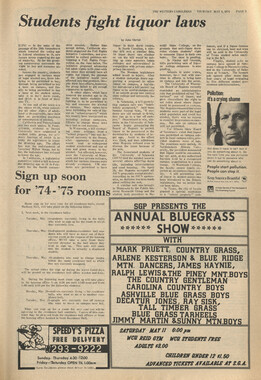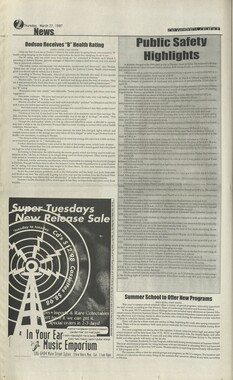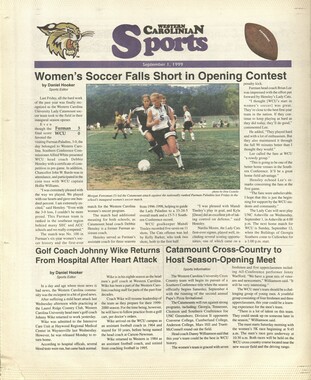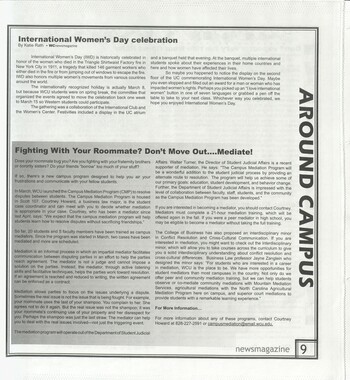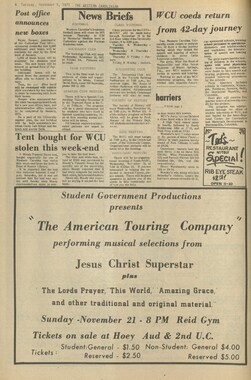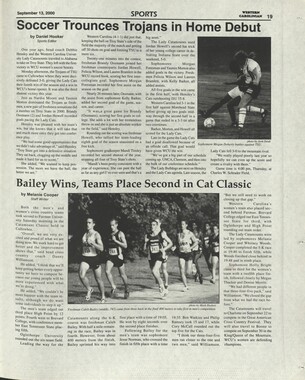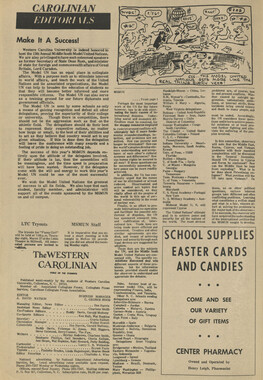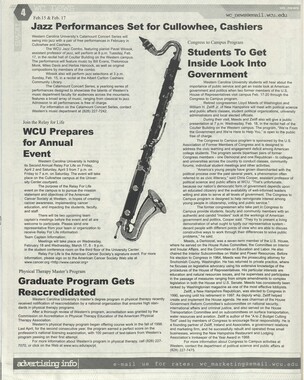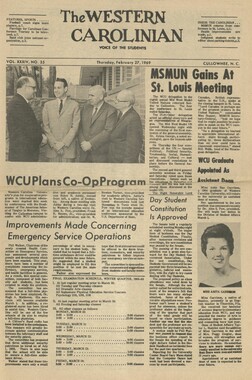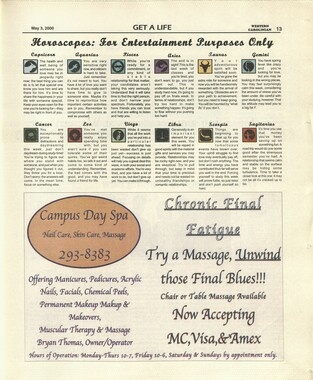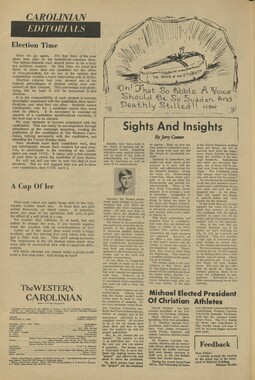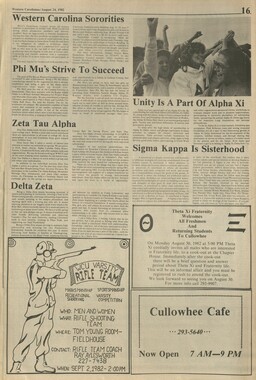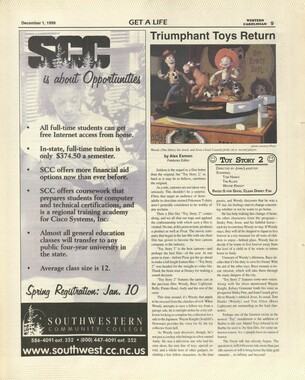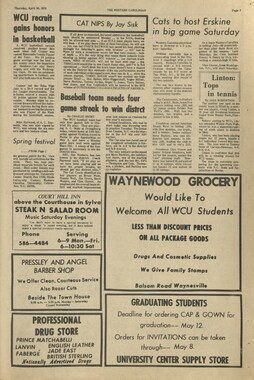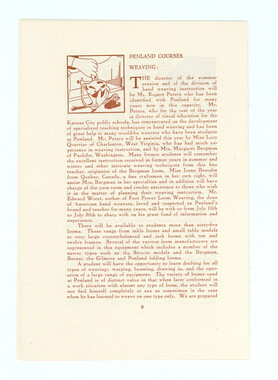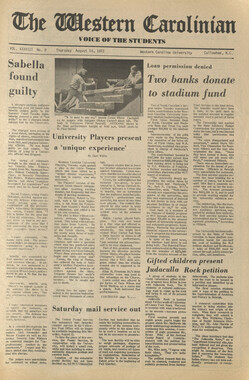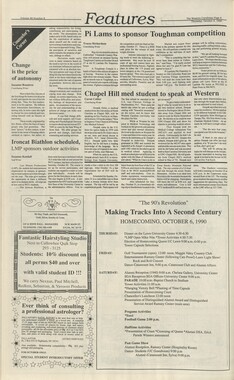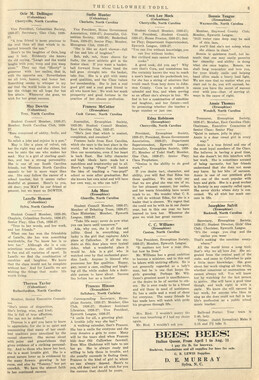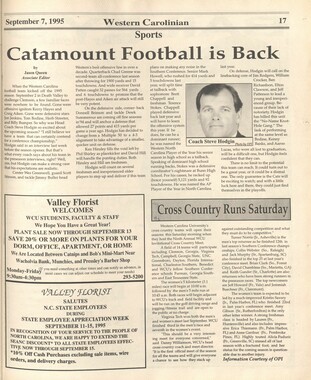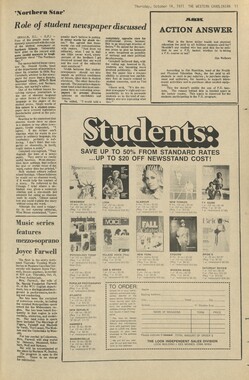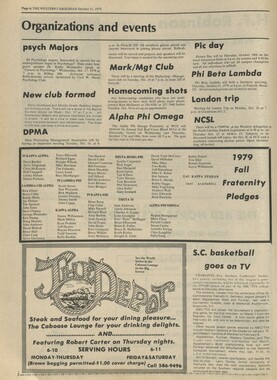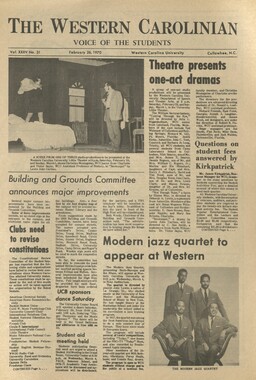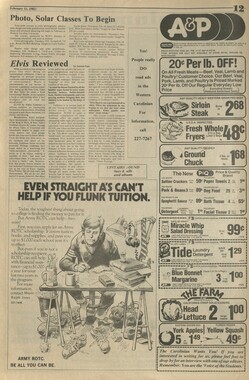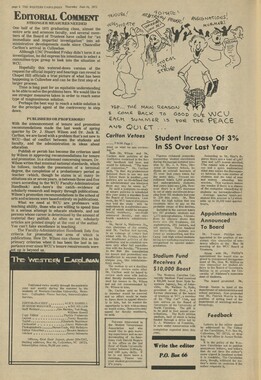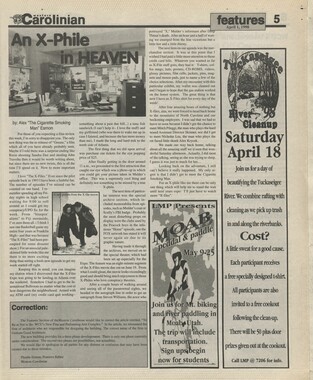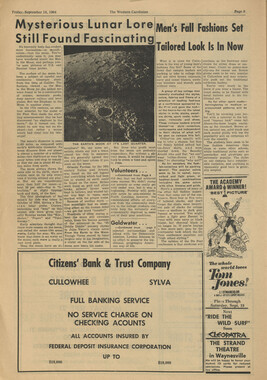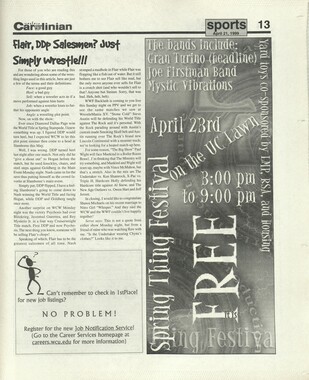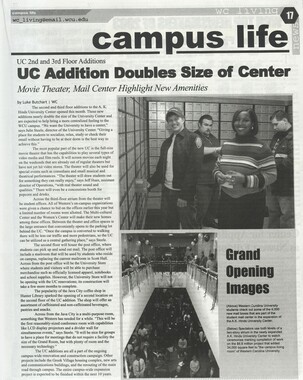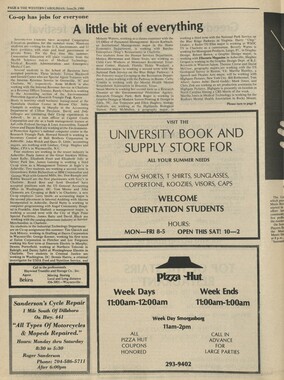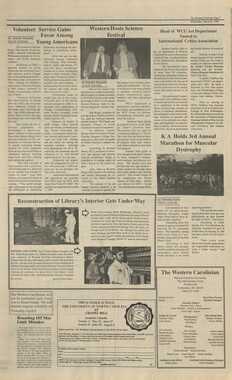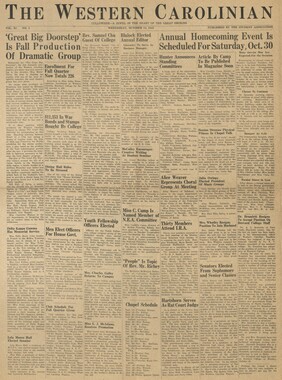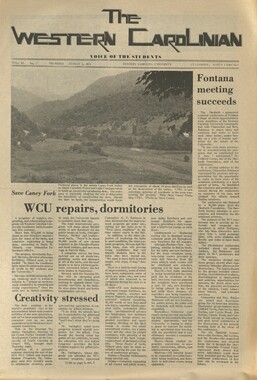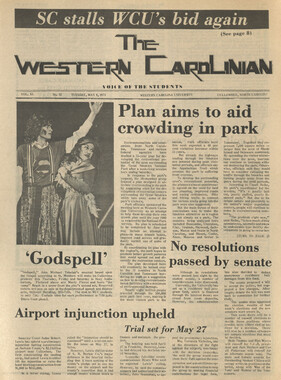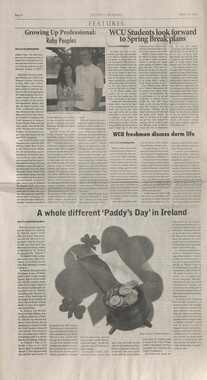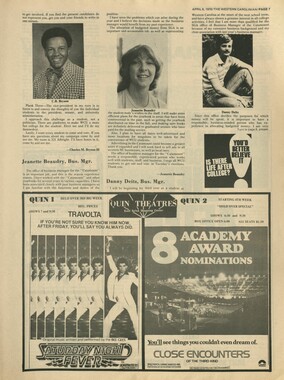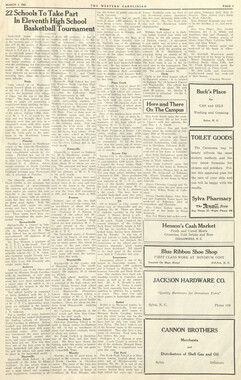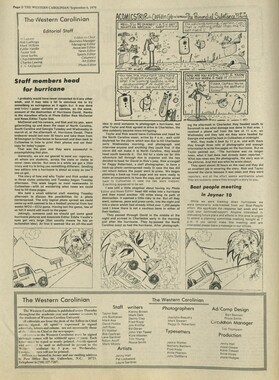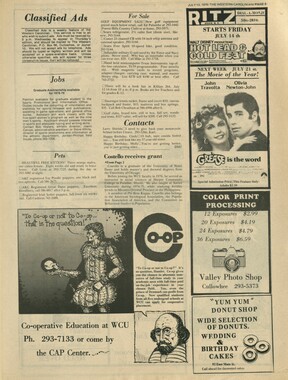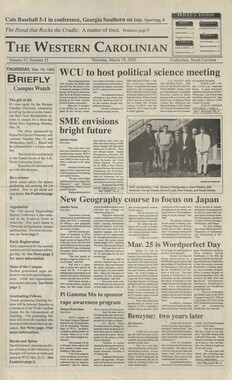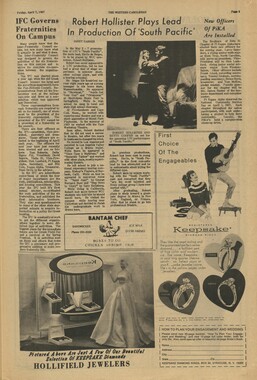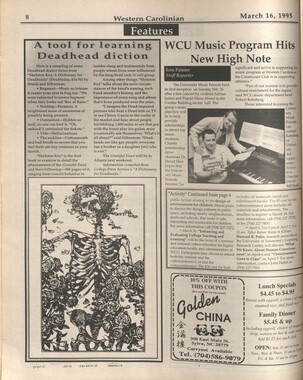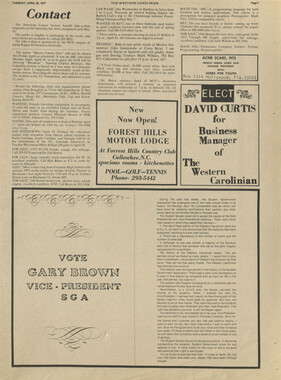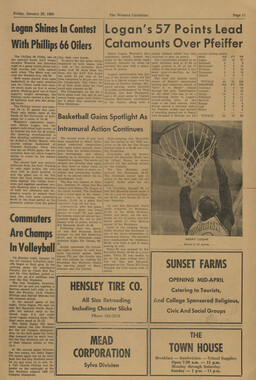Western Carolina University (21)
View all
- Canton Champion Fibre Company (2308)
- Cherokee Traditions (291)
- Civil War in Southern Appalachia (165)
- Craft Revival (1942)
- George Masa Collection (137)
- Great Smoky Mountains - A Park for America (2900)
- Highlights from Western Carolina University (422)
- Horace Kephart (973)
- Journeys Through Jackson (159)
- LGBTQIA+ Archive of Jackson County (85)
- Oral Histories of Western North Carolina (316)
- Picturing Appalachia (6797)
- Stories of Mountain Folk (413)
- Travel Western North Carolina (153)
- Western Carolina University Fine Art Museum Vitreograph Collection (129)
- Western Carolina University Herbarium (92)
- Western Carolina University: Making Memories (738)
- Western Carolina University Publications (2491)
- Western Carolina University Restricted Electronic Theses and Dissertations (146)
- Western North Carolina Regional Maps (71)
- World War II in Southern Appalachia (131)
University of North Carolina Asheville (6)
View all
- Allanstand Cottage Industries (62)
- Appalachian National Park Association (53)
- Bennett, Kelly, 1890-1974 (1463)
- Berry, Walter (76)
- Brasstown Carvers (40)
- Carver, George Washington, 1864?-1943 (26)
- Cathey, Joseph, 1803-1874 (1)
- Champion Fibre Company (233)
- Champion Paper and Fibre Company (297)
- Cherokee Indian Fair Association (16)
- Cherokee Language Program (22)
- Crowe, Amanda (40)
- Edmonston, Thomas Benton, 1842-1907 (7)
- Ensley, A. L. (Abraham Lincoln), 1865-1948 (275)
- Fromer, Irving Rhodes, 1913-1994 (70)
- George Butz (BFS 1907) (46)
- Goodrich, Frances Louisa (120)
- Grant, George Alexander, 1891-1964 (96)
- Heard, Marian Gladys (60)
- Kephart, Calvin, 1883-1969 (15)
- Kephart, Horace, 1862-1931 (313)
- Kephart, Laura, 1862-1954 (67)
- Laney, Gideon Thomas, 1889-1976 (439)
- Masa, George, 1881-1933 (61)
- McElhinney, William Julian, 1896-1953 (44)
- Niggli, Josephina, 1910-1983 (10)
- North Carolina Park Commission (105)
- Osborne, Kezia Stradley (9)
- Owens, Samuel Robert, 1918-1995 (11)
- Penland Weavers and Potters (36)
- Roberts, Vivienne (15)
- Roth, Albert, 1890-1974 (142)
- Schenck, Carl Alwin, 1868-1955 (1)
- Sherrill's Photography Studio (2565)
- Southern Highland Handicraft Guild (127)
- Southern Highlanders, Inc. (71)
- Stalcup, Jesse Bryson (46)
- Stearns, I. K. (213)
- Thompson, James Edward, 1880-1976 (226)
- United States. Indian Arts and Crafts Board (130)
- USFS (683)
- Vance, Zebulon Baird, 1830-1894 (1)
- Weaver, Zebulon, 1872-1948 (58)
- Western Carolina College (230)
- Western Carolina Teachers College (282)
- Western Carolina University (2008)
- Western Carolina University. Mountain Heritage Center (18)
- Whitman, Walt, 1819-1892 (10)
- Wilburn, Hiram Coleman, 1880-1967 (73)
- Williams, Isadora (3)
- Cain, Doreyl Ammons (0)
- Crittenden, Lorraine (0)
- Rhodes, Judy (0)
- Smith, Edward Clark (0)
- Appalachian Region, Southern (2940)
- Asheville (N.C.) (1944)
- Avery County (N.C.) (26)
- Blount County (Tenn.) (195)
- Buncombe County (N.C.) (1680)
- Cherokee County (N.C.) (283)
- Clay County (N.C.) (556)
- Graham County (N.C.) (238)
- Great Smoky Mountains National Park (N.C. and Tenn.) (525)
- Haywood County (N.C.) (3573)
- Henderson County (N.C.) (70)
- Jackson County (N.C.) (4919)
- Knox County (Tenn.) (35)
- Knoxville (Tenn.) (13)
- Lake Santeetlah (N.C.) (10)
- Macon County (N.C.) (421)
- Madison County (N.C.) (216)
- McDowell County (N.C.) (39)
- Mitchell County (N.C.) (135)
- Polk County (N.C.) (35)
- Qualla Boundary (982)
- Rutherford County (N.C.) (78)
- Swain County (N.C.) (2185)
- Transylvania County (N.C.) (270)
- Watauga County (N.C.) (12)
- Waynesville (N.C.) (86)
- Yancey County (N.C.) (72)
- Aerial Photographs (3)
- Aerial Views (60)
- Albums (books) (4)
- Articles (1)
- Artifacts (object Genre) (228)
- Bibliographies (1)
- Biography (general Genre) (2)
- Cards (information Artifacts) (38)
- Clippings (information Artifacts) (192)
- Copybooks (instructional Materials) (3)
- Crafts (art Genres) (622)
- Depictions (visual Works) (21)
- Design Drawings (1)
- Digital Moving Image Formats (2)
- Drawings (visual Works) (185)
- Envelopes (101)
- Exhibitions (events) (1)
- Facsimiles (reproductions) (1)
- Fiction (general Genre) (4)
- Financial Records (12)
- Fliers (printed Matter) (67)
- Glass Plate Negatives (381)
- Guidebooks (2)
- Internegatives (10)
- Interviews (817)
- Land Surveys (102)
- Letters (correspondence) (1045)
- Manuscripts (documents) (618)
- Maps (documents) (177)
- Memorandums (25)
- Minutes (administrative Records) (59)
- Negatives (photographs) (6090)
- Newsletters (1290)
- Newspapers (2)
- Notebooks (8)
- Occupation Currency (1)
- Paintings (visual Works) (1)
- Pen And Ink Drawings (1)
- Periodicals (193)
- Personal Narratives (10)
- Photographs (12976)
- Plans (maps) (1)
- Poetry (6)
- Portraits (4568)
- Postcards (329)
- Programs (documents) (181)
- Publications (documents) (2444)
- Questionnaires (65)
- Relief Prints (26)
- Sayings (literary Genre) (1)
- Scrapbooks (282)
- Sheet Music (2)
- Slides (photographs) (402)
- Songs (musical Compositions) (2)
- Sound Recordings (796)
- Specimens (92)
- Speeches (documents) (18)
- Tintypes (photographs) (8)
- Transcripts (324)
- Text Messages (0)
- A.L. Ensley Collection (275)
- Appalachian Industrial School Records (7)
- Appalachian National Park Association Records (336)
- Axley-Meroney Collection (2)
- Bayard Wootten Photograph Collection (20)
- Bethel Rural Community Organization Collection (7)
- Blumer Collection (5)
- C.W. Slagle Collection (20)
- Canton Area Historical Museum (2110)
- Carlos C. Campbell Collection (462)
- Cataloochee History Project (64)
- Cherokee Studies Collection (4)
- Daisy Dame Photograph Album (5)
- Daniel Boone VI Collection (1)
- Doris Ulmann Photograph Collection (112)
- Elizabeth H. Lasley Collection (1)
- Elizabeth Woolworth Szold Fleharty Collection (4)
- Frank Fry Collection (95)
- George Masa Collection (173)
- Gideon Laney Collection (452)
- Hazel Scarborough Collection (2)
- Hiram C. Wilburn Papers (28)
- Historic Photographs Collection (236)
- Horace Kephart Collection (861)
- Humbard Collection (33)
- Hunter and Weaver Families Collection (1)
- I. D. Blumenthal Collection (4)
- Isadora Williams Collection (4)
- Jesse Bryson Stalcup Collection (47)
- Jim Thompson Collection (224)
- John B. Battle Collection (7)
- John C. Campbell Folk School Records (80)
- John Parris Collection (6)
- Judaculla Rock project (2)
- Kelly Bennett Collection (1482)
- Love Family Papers (11)
- Major Wiley Parris Civil War Letters (3)
- Map Collection (12)
- McFee-Misemer Civil War Letters (34)
- Mountain Heritage Center Collection (4)
- Norburn - Robertson - Thomson Families Collection (44)
- Pauline Hood Collection (7)
- Pre-Guild Collection (2)
- Qualla Arts and Crafts Mutual Collection (12)
- R.A. Romanes Collection (681)
- Rosser H. Taylor Collection (1)
- Samuel Robert Owens Collection (94)
- Sara Madison Collection (144)
- Sherrill Studio Photo Collection (2558)
- Smoky Mountains Hiking Club Collection (616)
- Stories of Mountain Folk - Radio Programs (374)
- The Reporter, Western Carolina University (510)
- Venoy and Elizabeth Reed Collection (16)
- WCU Gender and Sexuality Oral History Project (32)
- WCU Mountain Heritage Center Oral Histories (25)
- WCU Oral History Collection - Mountain People, Mountain Lives (71)
- WCU Students Newspapers Collection (1923)
- Western North Carolina Tomorrow Black Oral History Project (69)
- William Williams Stringfield Collection (2)
- Zebulon Weaver Collection (109)
- African Americans (390)
- Appalachian Trail (35)
- Artisans (521)
- Cherokee art (84)
- Cherokee artists -- North Carolina (10)
- Cherokee language (21)
- Cherokee pottery (101)
- Cherokee women (208)
- Church buildings (190)
- Civilian Conservation Corps (U.S.) (111)
- College student newspapers and periodicals (2012)
- Dams (108)
- Dance (1023)
- Education (222)
- Floods (63)
- Folk music (1015)
- Forced removal, 1813-1903 (2)
- Forest conservation (220)
- Forests and forestry (1197)
- Gender nonconformity (4)
- Great Smoky Mountains National Park (N.C. and Tenn.) (181)
- Hunting (46)
- Landscape photography (25)
- Logging (119)
- Maps (83)
- Mines and mineral resources (9)
- North Carolina -- Maps (18)
- Paper industry (38)
- Postcards (255)
- Pottery (135)
- Railroad trains (72)
- Rural electrification -- North Carolina, Western (3)
- School integration -- Southern States (2)
- Segregation -- North Carolina, Western (5)
- Slavery (5)
- Sports (452)
- Storytelling (243)
- Waterfalls -- Great Smoky Mountains (N.C. and Tenn.) (66)
- Weaving -- Appalachian Region, Southern (280)
- Wood-carving -- Appalachian Region, Southern (328)
- World War, 1939-1945 (173)
Western Carolinian Volume 70 Number 10
Item
Item’s are ‘child’ level descriptions to ‘parent’ objects, (e.g. one page of a whole book).
-
-
22. WCnewsmagazine Title IX In Sports By Ryan Sarda + Wenewsmagazine Title IX is an amendment that is part of the Education Amendments of 1972 which prohibits gender discrimination in educational institutions that receive any federal funds. The amendment states, No person in the United States shall, on the basis of sex, be excluded from participation in, be denied the benefits of, or be subjected to discrimination under any educational program or activity receiving Federal financial assistance. The Title IX Amendment pertains to any student of an federally funded educational facility ranging from elementary schools to colleges throughout the country. Some private schools are covered but only if they receive federal funding through financial aid programs. If any institution violates the Title IX Amendment, they could lose their federal funds. The sports industry is where most of the controversy regarding Title IX occurs. In intercollegiate athletics, the Title IX Amendment governs equal treatment towards women as a whole, and gives them the same opportunities as men. It is not a matter of women being able to play football on campus, or women trying to compete on the wrestling team. It is a matter, however, of giving women the same and equal opportunities as men as a whole, not as individuals. There are two main areas that help define whether or not an institution is abiding by the amendment: athletic financial services and other program areas such as practice time, tutoring and publicit Financial Assistance must be substantiated by the number of male athletes and female athletes, and the total amount of financial assistance given must be proportionate to the ratio of male and female athletes. All other benefits, such as recruiting, money, and support services are to all By Zachary Colburn WGnewsmagazine February 1 was national signing day for colleges all over America to sign high school players to athletic scholarships. This raises a few questions; | where does that money come from and how it is divided at WCU? | The number of scholarships given to athletes at Western depends upon how many players are on a certain team. The largest number of scholarships are given to football and track teams because they have the most members. However, football and basketball receive the most scholarship money. The track team consists of both indoor and outdoor men's and womens track teams as well as both the mens and womens cross-country teams. The least amount of scholarships go to the womens and mens golf and the womens tennis team because these teams field the least amount of players. Both mens and womens basketball teams are strictly scholarship players. From information given by Athletic Director Chip Smith, the athletic department is billed by the Financial Aid Office for the student-athlete's scholarships at the beginning of each semester. This year, Western was given $1, 869,000 in scholarship money. That money is divided among the different teams at Western. Football receives 41% of that money, mens basketball 11%, women's basketball 10%, volleyball 8%, baseball 6%, womens track 5%, soccer 5%, womens golf 4%, tennis 4%, mens track 3% and men's golf rounds out the teams at 1%; no information was given on softball. These numbers have been rounded and do not equal 100%. This will change each year based on number of in and out-of-state scholarships awarded and the number of student-athletes who may leave the program, said Mr. Smith. Athletics do not receive state funding. The money comes from student fees, concessions, tickets and advertising that are brought in from the past equivalent but not necessarily identical. Title IX specifically looks at things such as the quality and quantity of equipment and supplies, equal opportunities for coaches or other personnel recruitment, equal publicity for mens and womens programs, medical training and insurance coverage for every student athlete, and the quality and maintenance of the locker rooms used by the athletes. Many students on campus agree with the Title IX Amendment, believing in its fairness and equality. I think Title IX is very fair. If | was told that | was not allowed to play a sport here on campus because of my sex, I'd be pretty upset and hurt. It provides equal treatment to both men and women in the sports world, said sophomore Lauren Priestley. 1 think Title IX gives equal treatment to men and women throughout the world, and | like that. However, what | do not like about it is the fact that if a group of girs feel unequal or treated unfairly, then their selective sports program loses their federal money, said sophomore Daniel Nickel. The Title IX Amendment has been the key in the development of womens sports. It has helped pave the way for womens professional sporis leagues such as the WNBA and the LPGA. A few non-college sporting leagues have given competition for both men and women in the same events. Afew examples are equestrian competitions, auto-racing, sailing, and inline skating, | think the Title IX Amendment helps drastically because | enjoy watching the WNBA and I like to watch women compete in sports predominantly ruled by males. For example, | really enjoyed watching Danica Patrick almost win the Indy 500 this year; | also watch Michelle Wie and Annika Sorenstam compete in the PGA Tour, said sophomore Mitchell Hutchings. Football and track teams receive the most scholarships school year because the scholarships are finalized before those athletes arrive for their freshman year of college. According to Smith, about one-third (32%) of the money from tickets and concessions go towards scholarships. Players can tu down a scholarship and stil be allowed to play for the university so that the scholarship can go to another deserving player. Athletes may turn down a scholarship if their parents can afford to pay for their education. According to Smith, if a player does not accept a college offer for reasons such as getting a better deal from another university, the scholarship can be offered to another student up until the first day of classes. After that, it goes to the Athletic Department's budget and is to be used at the director's discretion. The money for a walk-on player to become a scholarship player comes from the scholarship budget. The decision for this to happen is at the coach's discretion. Smith used this formula to find out the average pay fora coach at Western: take all the coaches and assistants salary and divide that amount by how many staff members there are. That average pay comes out to $39,750 per coach this season. Of that pay, Football and Basketball coaches are paid the most, Golf and Tennis coaches are paid the least because they are only part- time coaches. Gender has no barring on salary; basically, itis based upon market value, meaning that for a better quality coach, we have to be willing to pay a little more. In the end, it pays off in the number of wins the coaches earn and conference championships, Smith said.
Object
Object’s are ‘parent’ level descriptions to ‘children’ items, (e.g. a book with pages).
-
The Western Carolinian is Western Carolina University's student-run newspaper. The paper was published as the Cullowhee Yodel from 1924 to 1931 before changing its name to The Western Carolinian in 1933.
-

